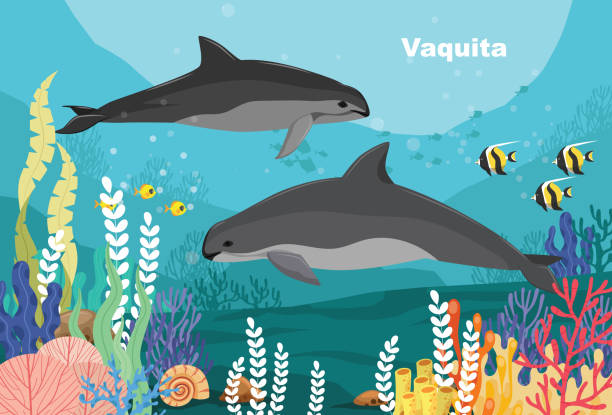Vaquita
The vaquita often referred to as the world’s most endangered cetacean, is a rare marine mammal that inhabits the northern part of the Gulf of California. This elusive species has garnered global attention due to its critically endangered status and the significant conservation efforts aimed at saving it from extinction. In this article, we will delve deep into the vaquita’s lifespan, size, and the environmental pressures it faces.
Vaquita’s Lifespan
The lifespan of a vaquita is relatively short compared to other marine mammals. On average, these porpoises live between 20 and 21 years in the wild. However, their lifespan is heavily influenced by environmental factors, human activities, and natural predators
Factors Affecting Lifespan
While the vaquita’s natural lifespan can extend over two decades, several factors are causing many to die prematurely:
Bycatch in Illegal Fishing Nets: The primary threat to the vaquita population is entanglement in gillnets, which are used illegally for catching the totoaba fish, another endangered species. These nets trap vaquitas, leading to drowning as they cannot surface to breathe.
Habitat Degradation: The Gulf of California is not immune to pollution, including industrial waste and agricultural runoff, which affects the water quality. These pollutants can weaken the vaquitas’ immune system, shortening their lifespan.

Vaquita Size: A Small yet Mighty Creature
The vaquita is known for being one of the smallest marine mammals. Its size plays a crucial role in its survival, allowing it to navigate shallow waters with ease, but it also makes it more vulnerable to fishing equipment.
Physical Characteristics
Vaquitas have a stocky, robust body that helps them thrive in the challenging waters of the Gulf of California. Below are the key aspects of the vaquita’s physical dimensions:
Length: Adult vaquitas typically measure between 4.6 and 5 feet (1.4 to 1.5 meters) in length.
Weight: They weigh between 95 and 120 pounds (43 to 55 kg), with females generally being larger than males.
Coloration: Vaquitas are easily identifiable by their distinct facial markings. They have dark rings around their eyes and lips, giving them a unique appearance compared to other porpoises.
Adaptations for Survival
Despite its small size, the vaquita is well-adapted to its environment. Its compact body allows for efficient swimming in the shallow waters of the northern Gulf of California, where the depth rarely exceeds 150 meters. The vaquita’s small stature also enables it to avoid predators such as sharks.

Conservation Challenges
Vaquita is teetering on the brink of extinction, and is listed as Critically Endangered by the IUCN. There are many conservation efforts, but challenges remain.
Impact of gillnets
The biggest threat to the vaquita is the use of illegal traps in particular. Totoaba blisters are valued in traditional Chinese medicine and fetch exorbitant prices in the vulnerable market. Unfortunately, walkers often get caught in this trap, causing them to drown because they can’t free themselves and reemerge for air.
Efforts to remove gillnets
To combat this, conservation groups and government agencies are working to remove gillnets from vaquita habitat. Sea Shepherd and the Mexican government have launched a campaign to patrol the Gulf and remove illegal traps. Despite these efforts, however, illegal fishing remains a serious threat.
Captive Birth Program
Efforts to breed vaquitas in captivity have been complicated by their fragility and the small number of survivors. In 2017, attempts to breed in captivity resulted in vaquita deaths, highlighting the species’ sensitivity to stress and confinement. So efforts to protect the remaining population in the wild have intensified.

The Vaquita’s Role in Marine Ecosystems
Vaquitas play a crucial role in maintaining the health of their ecosystem. As apex predators, they help regulate the populations of smaller fish and other marine species, ensuring the balance of the food web.
Ecological Impact of Vaquita Extinction
The extinction of the vaquita would have profound implications for the Gulf of California ecosystem. The disappearance of an apex predator can lead to overpopulation of certain species, which could negatively impact the biodiversity of the region.
Moreover, the loss of the vaquita could serve as a warning sign for other marine species facing similar threats due to human activities. As conservation efforts continue, the survival of the vaquita could inspire broader efforts to protect marine biodiversity globally.
The Future of the Vaquita
As the world becomes increasingly aware of the vaquita’s plight, there is still hope for its survival. International cooperation and stricter enforcement of fishing regulations could give the vaquita a fighting chance.
Hope Through Innovation
Innovative solutions, such as the development of vaquita-safe fishing gear, are being explored to reduce bycatch without impacting local communities who rely on fishing for their livelihood. Additionally, increasing public awareness about the vaquita’s situation is vital in garnering global support for conservation efforts.
What Can Be Done?
To save the vaquita, a multi-faceted approach is necessary. This includes:
- Strengthening the enforcement of fishing bans in the vaquita’s habitat.
- Promoting the use of sustainable fishing practices.
- Increasing international pressure on countries that import illegal totoaba bladders.
- Supporting local communities by providing alternative livelihoods that do not rely on illegal fishing.
Conclusion
The vaquita is a symbol of the delicate balance that exists within marine ecosystems and the devastating impact human activities can have on wildlife. Despite the challenges, there is still time to save this unique species if decisive action is taken. Protecting the vaquita not only preserves biodiversity in the Gulf of California but also serves as a broader lesson in the importance of marine conservation.






